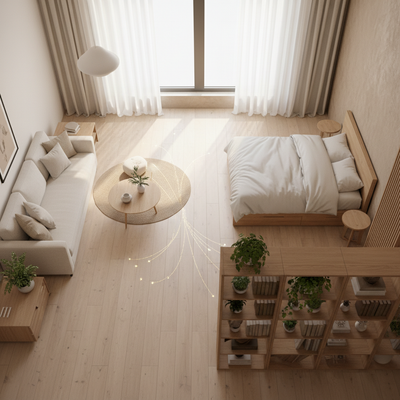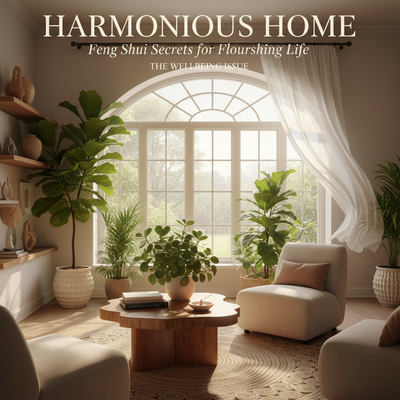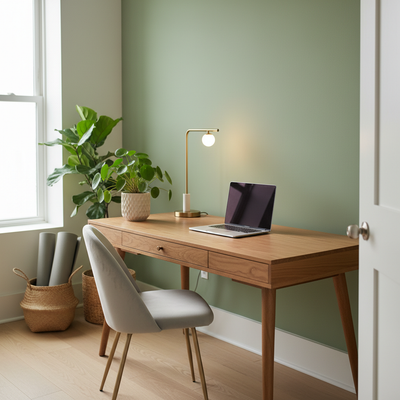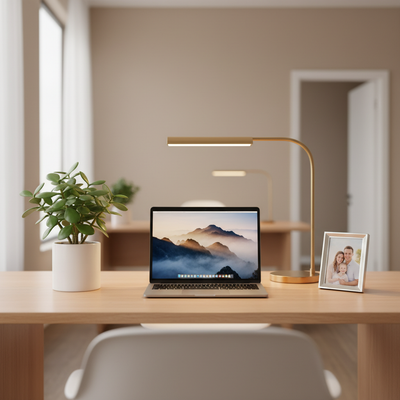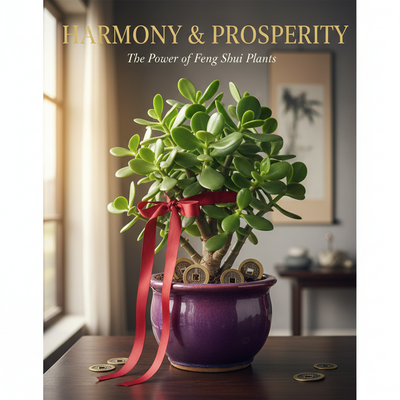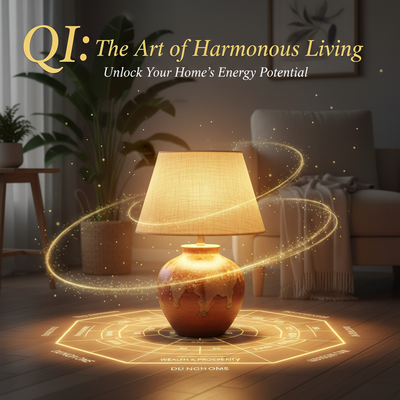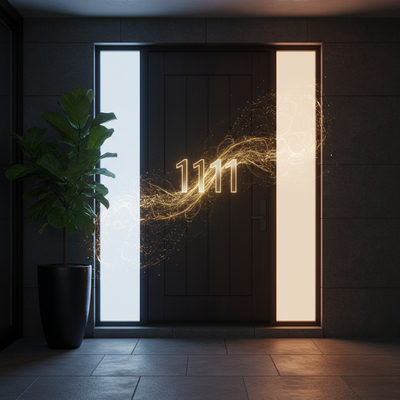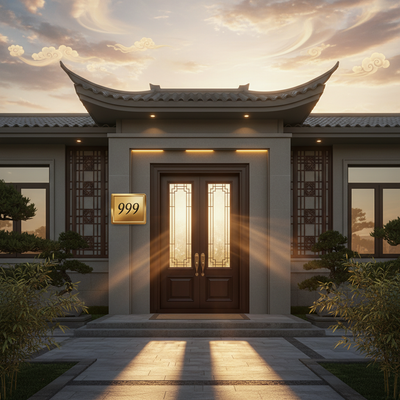The feeling of a home starts long before you walk through the front door. It begins at the street, with the first impression your house makes on the world, on your visitors, and on the natural energies around it. Have you ever noticed how some homes feel instantly welcoming and full of life, while others seem closed off or dull? This feeling is often connected directly to how the house looks from the outside, and especially, its color.
This is where the ancient practice of Feng Shui offers deep wisdom. Beyond just looking good, Feng Shui gives us a system for choosing exterior colors that can actively improve your home's energy. The right colors can attract positive Qi, the vital life force energy, creating a safe space that supports your health, wealth, and happiness. This guide will give you a clear path for selecting the perfect feng shui exterior colors. We will explore the basic ideas, show you how to find your home's unique energy pattern, and give specific color suggestions to transform your house into a balanced and vibrant home.
Why Your Home's Outside Matters

While many discussions of Feng Shui focus on interior layouts, the exterior of your home—its "skin"—is a critical and powerful starting point. It's the main connection between your private space and the outside world, acting as both a filter and a magnet for energy. Ignoring the exterior is like dressing for an important meeting without thinking about your clothes; the first impression sets the tone for everything that follows.
The "Mouth of Qi"
In traditional Feng Shui, the front of the house is often called the "Mouth of Qi" (Qi Kou). This is the main point through which energy, opportunities, and influences enter your life. The color of your home's exterior is the first thing this energy meets. Think of it like the clothing you wear. Your clothes communicate your personality, influence how others see you, and can make you feel more confident and capable. Similarly, your home's exterior color communicates its energetic personality to the universe, attracting a matching quality of Qi.
How Colors Affect People Living There
The choice of an exterior color is not just decorative; it has a real influence on the home's residents and the opportunities that come to them. A color that works well with the home's directional energy acts as a supportive and nourishing force. On the other hand, a color that clashes can create an underlying sense of imbalance or struggle.
Choosing your colors with purpose can bring significant benefits:
- Attracts positive opportunities for wealth and career growth.
- Supports the physical and emotional well-being of residents.
- Creates a protective and nourishing energetic shield around the home.
- Enhances curb appeal in a way that feels deeply harmonious and welcoming.
The Basic Principles
To make a smart color choice, we must first understand the language of Feng Shui: the Five Elements and the Bagua map. These two concepts are the foundation upon which all traditional Feng Shui recommendations are built. They provide a logical system for understanding how energy behaves and how we can guide it with color, shape, and material.
The Language of Energy
The Five Elements—Wood, Fire, Earth, Metal, and Water—are the building blocks of everything in the universe, including the energy of your home. Each element is connected with specific qualities, life areas, and, most importantly for our purpose, a distinct color palette. Understanding these relationships is the key to unlocking a harmonious color scheme.
| Element | Colors | Direction | Characteristic |
|---|---|---|---|
| Wood | Green, Brown | East, Southeast | Growth, Vitality, Expansion |
| Fire | Red, Strong Yellow, Orange, Purple, Pink | South | Passion, Fame, Recognition |
| Earth | Light Yellow, Sandy/Earthy, Beige | Northeast, Southwest, Center | Stability, Nourishment, Grounding |
| Metal | White, Gray, Metallic finishes | West, Northwest | Precision, Clarity, Joy |
| Water | Black, Dark Blue | North | Flow, Abundance, Career |
These elements exist in a dynamic relationship, most notably through the "Productive Cycle," where one element creates or nourishes the next: Water nourishes Wood, Wood fuels Fire, Fire creates Earth (ash), Earth produces Metal, and Metal creates Water (condensation). We will use this supportive cycle to select harmonious color palettes.
Mapping Your Home
For analyzing a home's exterior, we use the Compass School of Feng Shui. This method is a cornerstone of traditional practice, providing a systematic and time-tested approach to analyzing a property's energy. It aligns the eight primary compass directions (North, South, East, West, etc.) with specific life goals and one of the Five Elements. The "facing direction" of your home determines its primary elemental energy. By identifying this direction, you can choose a color that strengthens and supports this natural energy, bringing your entire home into alignment.
Find Your Facing Direction
Before you can choose a color, you must complete one important step: accurately determining your home's facing direction. This is the compass orientation that controls your home's primary energy and elemental connection. It's a common point of confusion for beginners, but the process is straightforward.
What is "Facing Direction"?
The facing direction is the side of your home that is most "Yang"—the most active, open, and architecturally defined side. This is typically the side with the main entrance, the most windows, and the side that was designed to face the world (often the street). While it is usually where the front door is located, this is not a universal rule. For example, if a home has a grand, window-filled wall facing a beautiful view and a modest entrance on the side, the view-facing wall might be considered the true facing direction. For most conventional homes, however, the front door is your guide.
A Simple 3-Step Guide
- Stand and Orient: Go to your main front door. Stand just inside the threshold, looking straight out from the house.
- Use a Compass: Hold a reliable compass level in front of you. A smartphone compass app can work, but ensure it's calibrated and held away from any metal objects (like keys, belt buckles, or steel door frames) that could interfere with the reading. A traditional magnetic compass is often more accurate.
-
Take the Reading: Note the precise degree measurement the compass needle is pointing to. This number is your home's facing direction. Now, convert that degree to its corresponding compass direction using the chart below.
-
North: 337.5° – 22.5°
- Northeast: 22.5° – 67.5°
- East: 67.5° – 112.5°
- Southeast: 112.5° – 157.5°
- South: 157.5° – 202.5°
- Southwest: 202.5° – 247.5°
- West: 247.5° – 292.5°
- Northwest: 292.5° – 337.5°
Once you have this direction, you have the key to unlocking your home's ideal color palette.
Colors by Compass Direction
Now we arrive at the heart of the matter: matching your home's facing direction with its corresponding elemental colors. The goal is to use colors that either belong to the direction's own element (strengthening it) or the element that produces it in the Productive Cycle (supporting it).
North (Water Element)
A North-facing home is connected to the Water element, which governs your Career and Path in Life. Colors that enhance this energy promote flow, wisdom, and social connections.
- Best Colors (Water Element): Black and all shades of dark blue. These directly resonate with the Water element.
- Supportive Colors (Metal Element): White, gray, and metallic hues. In the Productive Cycle, Metal produces Water, so these colors nourish and support the home's energy.
Northeast (Earth Element)
The Northeast direction is tied to the Earth element and influences Spiritual Growth, Knowledge, and self-cultivation. Colors should be grounding and stable.
- Best Colors (Earth Element): Light yellow, beige, and sandy or earthy tones. These colors are naturally stabilizing and nurturing.
- Supportive Colors (Fire Element): Reds, oranges, purples, and deep pinks. Fire creates Earth, so these passionate colors can be used to energize the home, ideally as accents on the door or trim.
East (Wood Element)
An East-facing home is governed by the Wood element, which is connected to Health, Family, and new beginnings. The energy here is about growth, vitality, and upward momentum.
- Best Colors (Wood Element): All shades of green and rich browns. These colors directly reflect the vibrancy of trees and plants.
- Supportive Colors (Water Element): Black and dark blues. Water nourishes Wood, so these colors provide the foundational support for growth and family harmony.
Southeast (Wood Element)
Like the East, the Southeast is also a Wood element direction, but it is specifically associated with Wealth and Abundance. The energy is about prosperous growth and expansion.
- Best Colors (Wood Element): Greens and browns are excellent choices here as well, fueling the energy of expansion.
- Supportive Colors (Water Element): Black and dark blues provide the essential nourishment for financial growth to flourish.
South (Fire Element)
The South is the most powerful Fire direction, governing Fame, Recognition, and your reputation in the world. The energy is bright, expansive, and social.
- Best Colors (Fire Element): Red, orange, strong yellow, purple, and pink. These colors are a direct expression of the vibrant Fire element.
- Supportive Colors (Wood Element): Greens and browns. Wood fuels Fire, so using these colors provides the substance needed for your reputation to grow.
Southwest (Earth Element)
The Southwest is an Earth element direction that holds the energy of Love, Marriage, and primary relationships. The goal is to create a stable, receptive, and nurturing environment.
- Best Colors (Earth Element): Sandy tones, beige, and light yellow create a welcoming and grounded feeling.
- Supportive Colors (Fire Element): Reds, pinks, and oranges are excellent choices, especially as accents. The passion of Fire strengthens the nurturing Earth energy of relationships.
West (Metal Element)
A West-facing home is associated with the Metal element, which governs Children and Creativity. This energy is about precision, joy, beauty, and completion.
- Best Colors (Metal Element): White, gray, and metallic finishes. These colors bring clarity, focus, and a sense of pristine beauty.
- Supportive Colors (Earth Element): Beige and earthy tones. Earth produces Metal, so these grounding colors provide the stability from which creativity and joy can spring.
Northwest (Metal Element)
The Northwest is also a Metal element direction, but it relates to Helpful People, Mentors, and travel. It's an energy of authority, leadership, and receiving support.
- Best Colors (Metal Element): White and gray are strong choices, reflecting the clarity and integrity of this sector.

- Supportive Colors (Earth Element): Earthy tones and beige provide the grounding support needed to establish oneself as a leader and attract helpful people.
Beyond the Basics
A truly harmonious home exterior is more than just a single block of color. It's a sophisticated palette where the main body, trim, and front door work together. By using the Five Element cycles, you can create a scheme that is not only beautiful but also energetically balanced and powerful. This holistic approach allows for nuance and addresses the architectural complexity of a real-world home.
Power of the Front Door
If the exterior is the "Mouth of Qi," the front door is the focal point of that mouth. Its color is especially potent and acts as a beacon, drawing specific energy to your home. You can use the door color to strongly amplify the energy of the facing direction or to introduce a balancing element. For example, a bright red door on a South-facing (Fire) home is a major booster for fame and recognition. On a North-facing (Water) home, a crisp white door (Metal element) can be used to support the Water energy and bring in clarity.
Using Trim to Balance
Trim color is a fantastic tool for creating energetic harmony. It can be used to introduce the supporting element from the Productive Cycle, adding a layer of depth to your color scheme. This creates a dynamic where the elements are actively working together. Consider a West-facing (Metal) home painted a classic white. While white is an excellent choice, adding trim in a sandy beige (Earth element) provides grounding support, as Earth produces Metal. This simple addition creates a home that feels not just clean and precise, but also stable and well-supported.
If You Can't Use the "Perfect" Color
In the real world, we face practical constraints. Homeowners' association (HOA) rules, neighborhood character, or personal taste may prevent you from painting your home black or bright red. This does not mean you cannot benefit from Feng Shui.
- Focus on the Door: If you can't use your ideal color on the main body, use it on the front door. A bold, elementally-correct door color can be enough to activate the desired energy.
- Use Accents: Apply the color to smaller but still significant features like shutters, window boxes, or porch furniture.
- Incorporate Materials: You can bring in an element through its material. For a North-facing home where you can't use black, add a metal water feature or large metal planters (Metal creates Water).
- Leverage Landscaping: The colors of your plants are a powerful way to balance energy. For a South-facing home in a neighborhood of neutral colors, planting masses of red and purple flowers near the foundation introduces the Fire element beautifully.
A Practical Walkthrough
Let's combine all this information into a real-world example. Imagine a homeowner has just moved into a new house and wants to choose an exterior paint color that is both beautiful and energetically supportive.
Step 1: Confirm the Direction
The homeowner stands at their front door, looking out, and uses a compass app on their phone. They are careful to stand away from the metal door frame. The compass gives a reading of 5 degrees. Consulting the chart, they confirm their home has a North-facing direction.
Step 2: Review the Palettes
Knowing the home is North-facing, the homeowner identifies its governing element as Water. They review the primary color palette for Water (black, dark blue) and the supportive color palette from the Metal element (white, gray, metallics), since Metal produces Water. They now have a curated list of harmonious colors to work with: black, dark blue, white, and gray.
Step 3: Making a Practical Choice
This is where real-world experience and personal preference come into play. The homeowner considers painting the entire house black. While this would be a powerful Water element statement, they feel it might be too stark and imposing for their sunny, family-friendly street. They want a look that is sophisticated but also welcoming.
They pivot to the supportive Metal palette. They decide on a deep, elegant charcoal gray for the main body of the house. This gray, a Metal element color, provides strong support for the North's Water energy without being as visually heavy as black. For the trim, they choose a crisp, clean white, also a Metal color, to create sharp definition and a classic look.
Finally, for the front door—the energetic focal point—they decide to make a bold statement. They choose a high-gloss, true black. This powerful Water element color will act as a strong magnet for career opportunities and positive life-path energy, drawing it directly into the home.
The Final Harmonious Result
The finished home is stunning. The charcoal gray body looks sophisticated and stable, the white trim makes the architectural details pop, and the glossy black door serves as an elegant and powerful focal point. The overall effect is one of quiet confidence and welcome. Energetically, the home is now perfectly aligned. The supportive Metal colors of the body and trim create a foundation of clarity, while the potent Water color of the door strongly activates the home's inherent career and life-flow energy.
Colors to Use with Caution
Just as the Productive Cycle shows us which elements support each other, the "Controlling Cycle" shows us which elements clash. Using a color from a controlling element for the main body of your house can weaken its natural energy, creating imbalance. While small accents are generally fine, the main color should not be in conflict with the home's directional energy.
-
Avoid Fire on a Metal Home: For a West or Northwest-facing (Metal) home, avoid using large amounts of red, orange, or purple. In the elemental cycle, Fire melts Metal. A predominantly red house in a Metal direction can weaken the energy of clarity, organization, and joy.
-
Avoid Metal on a Wood Home: For an East or Southeast-facing (Wood) home, avoid an all-white or all-gray color scheme. Metal chops Wood. An excess of Metal colors can suppress the home's vital energy of growth, health, and family harmony.
-
Avoid Wood on an Earth Home: For a Northeast or Southwest-facing (Earth) home, avoid using too much green. Wood digs into and depletes Earth, which can disrupt the energy of stability and relationships.
-
Avoid Earth on a Water Home: For a North-facing (Water) home, be cautious with a predominantly beige or yellow exterior. Earth dams and blocks Water, which can lead to a feeling of stagnation in one's career or life path.
-
Avoid Water on a Fire Home: For a South-facing (Fire) home, avoid black or dark blue as the main color. Water extinguishes Fire, which can dampen the energy of recognition, fame, and social vibrancy.
When Your Home is Complex
This guide provides a powerful and effective framework for most homes. However, some properties have unique characteristics or challenges that require a more detailed analysis than a general article can provide. Recognizing when you need a deeper look is a key part of the process.
When to Seek Expert Guidance
A professional consultation is highly recommended in certain situations. You may benefit from expert guidance if:
- Your house has a highly unusual shape (L-shaped, U-shaped) or sits on an odd-shaped lot.
- The front door is clearly not on the main "Yang" or active side of the house.
- The home's facing direction falls directly on a dividing line between two directions.
- You want to integrate the personal birth elements (Kua numbers) of the occupants for a truly personalized color scheme.
- You simply feel overwhelmed by the choices and desire a personalized, in-depth analysis to ensure the best possible outcome.
How a Feng Shui Expert Can Help
A professional Feng Shui consultant can perform a much more detailed audit, moving beyond the general principles to a highly specific and tailored solution. For these intricate scenarios, a detailed analysis is key. Teams like THE QI FLOW specialize in just this. They go beyond the facing direction to analyze the home's entire energy chart, consider the birth data of the family members, and assess the surrounding landscape. This allows them to create a truly customized color strategy that resolves conflicts and maximizes the positive potential for your specific home and family, ensuring every color choice is made with precision and purpose.
Conclusion: Paint with Intention
Choosing your home's exterior color is one of the most impactful decisions you can make for its energy and curb appeal. By moving beyond fleeting trends and embracing the timeless wisdom of Feng Shui, you transform a simple act of maintenance into a powerful act of intention. The process is clear: identify your home's facing direction, understand its corresponding element, and choose feng shui exterior colors that strengthen and support its natural energy.
Remember that your home is a living entity, constantly interacting with the world around it. Painting its exterior with purpose is a declaration of the kind of energy you wish to cultivate. It is an investment in a home that not only looks beautiful but also feels harmonious, supportive, and alive with positive Qi for years to come.
